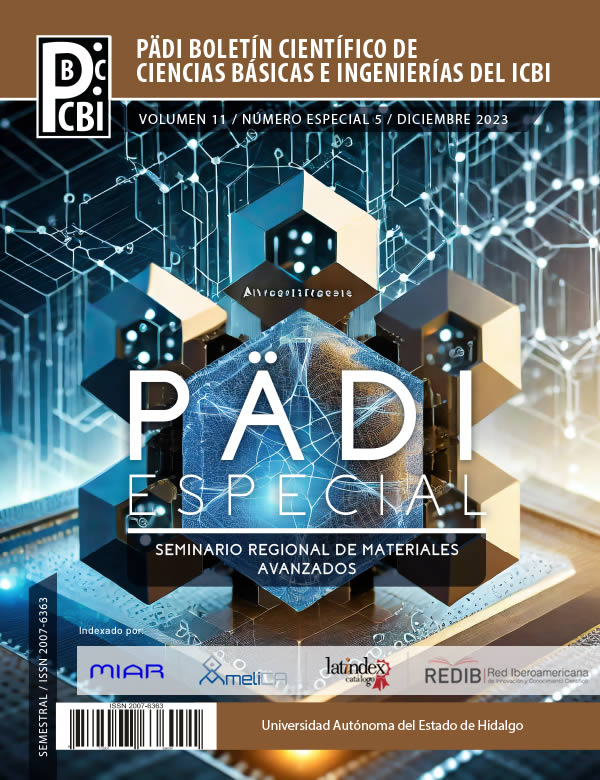Español
Abstract
In this work, the acetylation of potato starch (PS) was prepared in acidic medium using molar ratios (RM) of PS/acetic anhydride (AnAc) of 1:0.5, 1:1, and 1:1.5. The characterization of acetylated starch (AcS) was realized for FT-IR, volumetric analysis, 1H NMR, and SEM. Specific viscosity (ηsp ) and paste viscosity were determined. Degree of substitution (DS) values of 0.14, 0.45, and 1.08 were obtained with reaction yields of 28%, 45%, and 75%, respectively. In this case the acetylation reactions can be controlled by RM. Thus, DS and reaction yield increases with an increase the RM, which appears to be related to greater fragmentation of PS granules. The analysis of η sp and paste viscosity revealed that the combination of hydrolysis reactions and associations of hydrophobic regions influence the viscosity of AcS.
Downloads
References
Bello-Pérez, L. A., Agama-Acevedo, E., Zamudio-Flores, P. B., Mendez-Montealvo, G., & Rodriguez-Ambriz, S. L. (2010).
Effect of low and high acetylation degree in the morphological, physicochemical and structural characteristics of barley starch. LWT, 43(9), 1434–1440. https://doi.org/10.1016/j.lwt.2010.04.003
Chi, H., Xu, K., Wu, X., Chen, Q., Xue, D., Song, C., Zhang, W., & Wang, P. (2008).
Effect of acetylation on the properties of corn starch. Food Chemistry, 106(3), 923–928. https://doi.org/10.1016/j.foodchem.2007.07.002
Colussi, R., El Halal, S. L. M., Pinto, V. Z., Bartz, J., Gutkoski, L. C., Zavareze, E. da R., & Dias, A. R. G. (2015). Acetylation of rice starch in an aqueous medium for use in food. LWT - Food Science and Technology, 62(2), 1076–1082. https://doi.org/10.1016/J.LWT.2015.01.053
Elomaa, M., Asplund, T., Soininen, P., Laatikainen, R., Peltonen, S., Hyvärinen, S., & Urtti, A. (2004). Determination of the degree of substitution of acetylated starch by hydrolysis, 1H NMR and TGA/IR. Carbohydrate Polymers, 57(3), 261–267. https://doi.org/10.1016/j.carbpol.2004.05.003
Goheen, S. M., & Wool, R. P. (1991). Degradation of Polyethylene-Starch Blends in Soil.
Hadi, N. A., Wiege, B., Stabenau, S., Marefati, A., & Rayner, M. (2020).
Comparison of three methods to determine the degree of substitution of quinoa and rice starch acetates, propionates, and butyrates: Direct stoichiometry, FTIR, and 1H-NMR. Foods, 9(1). https://doi.org/10.3390/foods9010083
Jiang, T., Duan, Q., Zhu, J., Liu, H., & Yu, L. (2020). Starch-based biodegradable materials: Challenges and opportunities. Advanced Industrial and Engineering Polymer Research, 3(1), 8–18.
https://doi.org/10.1016/J.AIEPR.2019.11.003
Kumar, R., & Khatkar, B. S. (2017). Thermal, pasting and morphological properties of starch granules of wheat
(Triticum aestivum L.) varieties. Journal of Food Science and Technology, 54(8), 2403–2410. https://doi.org/10.1007/s13197-017-2681-x
Miladinov, V. D., & Hanna, M. A. (2000). Starch esterification by reactive extrusion. In Industrial Crops and Products (Vol. 11). www.elsevier.com
Rodriguez-Gonzalez, F. J., Ramsay, B. A., & Favis, B. D. (2004). Rheological and thermal properties of thermoplastic starch with high glycerol content. Carbohydrate Polymers, 58(2), 139–147. https://doi.org/10.1016/j.carbpol.2004.06.002
Singh, J., Kaur, L., & Singh, N. (2004). Effect of acetylation on some properties of corn and potato starches. Starch/Staerke, 56(12), 586–601. https://doi.org/10.1002/star.200400293
Sodhi, N. S., & Singh, N. (2005). Characteristics of acetylated starches prepared using starches separated from different rice cultivars. Journal of Food Engineering, 70(1), 117–127. https://doi.org/10.1016/j.jfoodeng.2004.09.018
Sun, S., Zhang, G., & Ma, C. (2016). Preparation, physicochemical characterization and application of acetylated lotus rhizome starches. Carbohydrate Polymers, 135, 10–17. https://doi.org/10.1016/j.carbpol.2015.07.090
Wang, L., Wang, W., Wang, Y., Xiong, G., Mei, X., Wu, W., Ding, A., Li, X., Qiao, Y., & Liao, L. (2018). Effects of fatty acid chain length on properties of potato starch–fatty acid complexes under partially gelatinization. International Journal of Food Properties, 21(1), 2121–2134. https://doi.org/10.1080/10942912.2018.1489842
Wang, X., Gao, W. Y., Zhang, L. M., Xiao, P. G., Yao, L. P., Liu, Y., Li, K. F., & Xie, W. G. (2008). Study on the morphology, crystalline structure and thermal properties of yam starch acetates with different degrees of substitution. Science in China, Series B: Chemistry, 51(9), 859–865. https://doi.org/10.1007/s11426-008-0089-1
Wang, X., Huang, L., Zhang, C., Deng, Y., Xie, P., Liu, L., & Cheng, J. (2020). Research advances in chemical modifications of starch for hydrophobicity and its applications: A review. Carbohydrate Polymers, 240, 116292. https://doi.org/10.1016/J.CARBPOL.2020.116292
Xu, J., & Shi, Y. C. (2019). Position of acetyl groups on anhydroglucose unit in acetylated starches with intermediate degrees of substitution. Carbohydrate Polymers, 220, 118–125. https://doi.org/10.1016/J.CARBPOL.2019.05.059
Zhang, L., Xie, W., Zhao, X., Liu, Y., & Gao, W. (2009). Study on the morphology, crystalline structure and thermal properties of yellow ginger starch acetates with different degrees of substitution. Thermochimica Acta, 495(1–2), 57–62. https://doi.org/10.1016/j.tca.2009.05.019
Copyright (c) 2023 Lucero Vargas González, Isaura Félix Serrano, Francisco Javier Rodríguez González , Héctor Ricardo López González , Damaso Navarro Rodríguez

This work is licensed under a Creative Commons Attribution-NonCommercial-NoDerivatives 4.0 International License.













